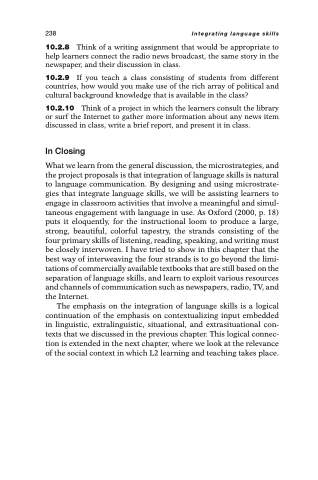Page 250 - Beyond Methods
P. 250
238 Integrating language skills
10.2.8 Think of a writing assignment that would be appropriate to help learners connect the radio news broadcast, the same story in the newspaper, and their discussion in class.
10.2.9 If you teach a class consisting of students from different countries, how would you make use of the rich array of political and cultural background knowledge that is available in the class?
10.2.10 Think of a project in which the learners consult the library or surf the Internet to gather more information about any news item discussed in class, write a brief report, and present it in class.
In Closing
What we learn from the general discussion, the microstrategies, and the project proposals is that integration of language skills is natural to language communication. By designing and using microstrate- gies that integrate language skills, we will be assisting learners to engage in classroom activities that involve a meaningful and simul- taneous engagement with language in use. As Oxford (2000, p. 18) puts it eloquently, for the instructional loom to produce a large, strong, beautiful, colorful tapestry, the strands consisting of the four primary skills of listening, reading, speaking, and writing must be closely interwoven. I have tried to show in this chapter that the best way of interweaving the four strands is to go beyond the limi- tations of commercially available textbooks that are still based on the separation of language skills, and learn to exploit various resources and channels of communication such as newspapers, radio, TV, and the Internet.
The emphasis on the integration of language skills is a logical continuation of the emphasis on contextualizing input embedded in linguistic, extralinguistic, situational, and extrasituational con- texts that we discussed in the previous chapter. This logical connec- tion is extended in the next chapter, where we look at the relevance of the social context in which L2 learning and teaching takes place.


